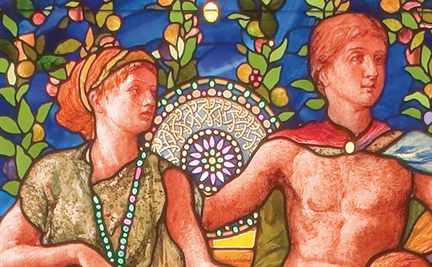John LaFarge was a late 19th century painter who studied at Newport, Rhode Island under William Morris Hunt, brother of Beaux-Arts master architect Richard Morris Hunt. LaFarge would go on to illustrate books by Tennyson and Browning, and paint his first mural for Trinity Church in Boston.
But it’s his later work in opalescent stained glass that’s earned him an honored place in art history.
“He changed glass altogether,” says Leslie Klingner, curator of interpretation at Biltmore Estate in Asheville, N.C. “For 500 years it had been flat, but LaFarge broke the mold and incorporated three-dimensional elements into it, and added light, movement and sparkle.”
It’s said that he experienced an epiphany that altered the course of his work when he fell ill during the 1860s. “He saw sunlight pouring through a medicine bottle and decided to go into glass,” she says.
At the time, stained glass was less art than it was manufacturing. LaFarge, though, approached the craft from a new perspective. He would make his own glass, pouring it out onto a large, flat, steel marver. While it was still hot, he would don asbestos gloves and sculpt the surface for texture and wrinkles, then add pigments, gold and minerals.
“It’s almost like a collage,” she says. “There are some dark areas and some surface work. Some of it’s cut or faceted while other pieces are mold-blown jewels. He painted the back of the glass with vitreous enamel, and fired it for glazing.”
To achieve his uncannily human skin tones, LaFarge started with glass possessed of a rosy hue, then added layers of paint on its back. “It was not opaque, but gradiated on,” she says. “He made totally flat glass glow and seem circular from all angles.”
Nowhere are his talents more evident than in a series of three triptychs developed in 1881 for William Henry Vanderbilt’s home at 640 Fifth Avenue in Manhattan. The residence – the largest in New York at the time – required the services of two architects for its design. John Butler Snook would design its brownstone Greek Revival exterior, while Charles B. Atwood was responsible for its interiors, including stained glass panels for its three-story, western-facing entryway and staircase. These were commissioned to LaFarge.
The narrative of the three triptychs vividly embraces the mythic symbology of the Vanderbilt family’s legacy. On the ground level, the first three glass panels are dedicated to the fruits of commerce, depicting the triumphs of the Vanderbilt enterprises. On the second level, a viewer would have looked up to see the symbols of hospitality and prosperity surrounding matriarch and patriarch. And on the third floor is illustrated the myth of the Golden Apples of the Hesperides – the last and most difficult of Heracles’ 12 tasks – which introduced the concept of immortality for the Vanderbilt family.
“Their legacy in America is immortality,” she says. “You can’t walk down the street in New York and not see something that the Vanderbilts have had an impact on. And the same is true here in Asheville.”
Though 640 Fifth Avenue was transformed cellar to attic by Grace Vanderbilt in 1916, the LaFarge stained glass triptychs had already been packed up by Edith Vanderbilt in 1890 and later shipped to Biltmore Estate. There they remained in storage until early this year, when one of them – that of the middle level, depicting hospitality and prosperity – was placed on display at the Biltmore Legacy center in Antler Hill Village, the new entertainment, dining and shopping green on the estate.
It’s there for all to see today – a crown jewel from America’s most opulent era.
For more, go here.
[slideshow id=189]


